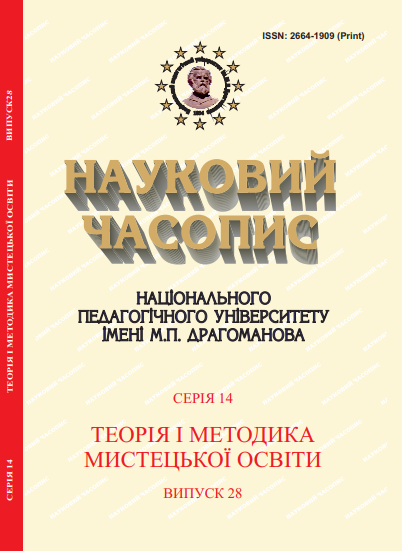Diagnostic methods measuring of musical and rhythmic skills of students within the ascertaining stage of the experiment at the arts faculties
DOI:
https://doi.org/10.31392/NPU-nc.series14.2022.28.16Keywords:
diagnostic methods, musical and rhythmic skills, ascertaining stage of research and experimental workAbstract
The article reveals the specifics of the use of diagnostic methods for measuring the formation of musical and rhythmic skills of students at the arts faculties within the research and experimental work. The purpose of the article is to reveal the content of diagnostic methods of forming musical and rhythmic skills of future teachers of choreography art. The current development of art and pedagogical education is connected with the qualitative renewal of the higher education system in general. Of particular importance is the problem of training a teacher capable of implementing innovative methods. Therefore, the problem of forming musical and rhythmic skills of future teachers of choreography art looks extremely important for the researcher. It is necessary to effectively use musical and rhythmic exercises that help to successfully form a sense of metro-rhythm of the performer with various differentiated operations of motor apparatus. The diagnostic methodology included checking the formation of musical and rhythmic skills of future teachers of choreography art according to the criteria and indicators of the cognitive-motivational, cognitive-initiative and result-activity components. The presented diagnosis of skills of students at the ascertaining stage of research and experimental work took place according to the developed component structure, made it possible to highlight the real formation of this specified phenomenon. Wide use of these diagnostic techniques allows students to more easily overcome certain musical and rhythmic difficulties they face in practical work with schoolchildren. In the process of acquiring the necessary practical skills, future teachers of choreography will feel more confident in their professional work in the future.
References
Авксентієва С. (2014), Активні методи навчання у формуванні професійної майстерності педагога-музиканта. Проблеми підготовки сучасного вчителя, №9 (ч.1). С. 12-23.
Алексюк А.М. (1998), Самостійна робота студентів. Педагогіка вищої школи України. Київ. С. 433-439.
Ван Юаньсінь. (2021), Методика діагностики музично-ритмічної компетентності майбутніх учителів музики і хореографії. Multidisciplinary Scientific journal: Paradigm of Knowledge: DOL 10.26886. Vol. 4 (48), 2021. Franfkfurt. Р. 118-135. ISSN 2520-7474.
Havrilova L., Kozyr, A., Ishutina, O., Khvashchevska, O. & Chuhai, S. (2020). Analysis and Interpretation of Yuri Chugunov’s Suite of Moods for Saxophone and Piano. OPUS. ANPPOM’s Eletronic Journal. Vol 26, No 1. DOI: http://dx.doi.org/10.20504/opus2020a2605
Масол Л. М. (2015), Художньо-педагогічні технології в основній школі: єдність навчання і виховання: метод. посіб. Харків: «Друкарня Мадрид». 178 с.
Мелехов А.В. (2015), Искусство балетмейстера. Композиция и постановка танца: учеб. пособие; Урал. гос. пед. ун-т. Екатеринбург, 2015. 128 с.
Орлов В.Ф. (2003), Професійне становлення вчителів мистецьких дисциплін: теорія і технологія: монографія за заг. ред. І.А.Зязюна. К.: Наукова думка. 262 с.
Падалка Г.М. (2008), Педагогіка мистецтва (теорія і методика викладання мистецьких дисциплін). Київ: Освіта України, 2008. 274 с.
Психологія та педагогіка: навч.-метод. посіб. (2008), Для сам ост.вивч.дисц. Л.В. Музичко, А.В. Тішакова, Л.В. Корват та ін.; за ред. Л.В. Музичко. К.: КНЕУ. 304 с.
Психологические тесты в 2-х т. под ред. А.А. Карелина. (2003), М.: ВЛАДОС. Т. 1. 312 с.
Ростовський О.Я. (1991), Взаємозв`язок різних видів мистецтва на уроках музики. К.: Освіта. 48 с.
Рудницька О.П. (2005), Педагогіка загальна та мистецька. Тернопіль: Навч.кн. "Богдан". 359 с.
Соколова О.В. (2011) Інтегративний підхід у вивченні мистецьких дисциплін в умовах теоретичної підготовки учителів музики і художньої культури. Науковий часопис НПУ імені М.П. Драгоманова. Серія 14: Теорія і методика мистецької освіти: зб. наук. праць. К.: Вид-во НПУ імені М.П. Драгоманова. Вип. 11 (16). С. 93-96.
Сучасний урок. Інтерактивні технології навчання: Наук.-метод. посібн. (2004), О.І.Пометун, Л.В.Пироженко. К.: Видавництво А.С.К. 192 с.
Сучасні інформаційні технології та інноваційні методики навчання у підготовці фахівців: методологія, теорія, досвід, проблеми. (2007). Зб. наук. пр. Вип. 15. Редкол. І.А. Зязюн (голова) та ін. Київ-Вінниця: ДОВ «Вінниця». 492 с.
Rhythm perception, rhythm production and timing (1989). Psychological Research, Jun. Vol. 51 (1). P. 213-251.
Seashor C.E. (1990), Psychology of Musik. N.Y. 357 p.
Willoygby D. (1996), The World of Musik. Third ed. Boston: MacGraw-Hill. 381 р.
Downloads
Published
Issue
Section
License
Copyright (c) 2022 Nauk. čas. Nac. pedagogìčnogo unìv. ìm. M.P. Dragomanova, Ser. 14, Teor. metod. mistec. osv. [Scientific journal NPDU. Series 14. Theory and methodology of arts education]

This work is licensed under a Creative Commons Attribution-NonCommercial-NoDerivatives 4.0 International License.

